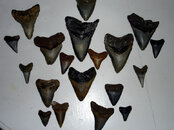Meg Ledges that have been hot for about the last 10 years are in proximity to Frying Pan Tower, about 8 or so miles from the tip of frying pan shoals. They are about 37 miles from land, depending upon you departure point, this distance can vary. For most of the charters out of Wrightsville Beach, its a long boat ride out there....usually about 2 hours, more if the boat is slow. There can be current on the site, and occasionally strong enough to prohibit diving. In 2005, Wilmington area diver Greg Mickey was swept away from the diveboat in heavy currents, and perished. One of his dive buddies was recovered by the Coast Guard.....so, currents can be an issue there.
The Disneyland area (its called Disneyland because that is how it used to be..full of tropical fish, spiney lobster, meg teeth, gags, etc.) is often dived for Meg Teeth, and interchangeably called, "Meg Ledge, Fossil Ledge, Tooth Ledge". There are other tooth ledges, like Shark's Tooth Ledge closer to shore, but the most productive area is Disneyland. Disneyland is probably productive because it is broken up. Where it sits near Frying Pan Shoals is pounded by violent seas, surge, and wave actions during Hurricanes. Most of the other ledges are more intact, while Disneyland is more broken up and stewn about. These ledges are prehistoric shorelines from Ice Ages, and contain vast fossil deposits. When the ledges are broken up, the fossils (including shark teeth of all types..small, medium, and large) are strewn about.
Disneyland ranges anywhere from 95 fsw to 110fsw, depending on where you dive it at, the deepest portions tend to be the most productive..the low side of the ledges. Dive boats typically chain in to a large broken off piece of ledge, that look like boulders, there are no mooring bouys out there. Divers descend the anchor line, tie off their reel in proximity to the anchor, reel out, and look for teeth along their chosen path.
Private boats have been diving there for many years, and Spearit Charters also ran those Meg Teeth runs for years. When Greg Mickey was killed, the site was unzipped from its secrecy, and there has been a practical "Gold Rush" for Meg Teeth ever since. The ledge seemed to have dried up in the last year or so, and fewer teeth have been found. When I first dove there, there were Meg teeth laying all over the place, littering the bottom. Now you have to really dig and look to find them. However, after Hurricane Irene, the ledge was broken up again by the surge action produced by the storm, and a new rush was on for teeth at the freshly broken up Disneyland.
32% Nitrox works there, but some local divers on some of the private boats are pushing the limits. On the dive charters I have been on, it is not uncommon to see multiple OOA's and blown decompression with beeping computers. Because of these issues, some of the Charter Operators hate these dives because of the issues that happen on them. Personally, I'd rather dive the Rosin Wreck, Normannia, 18 Fathom, etc. if I'm going to be on that long of a boatride. Disneyland has become a bit of a disaster. These are what all the fuss is about:





